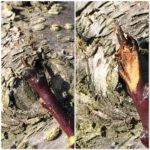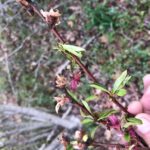Peach:
Oriental Fruit Moth: First generation timings are updated below: Growers that have utilized mating disruption for OFM can focus on PC; GPA; and catfacing insect pests as described below. If you have not placed mating disruption dispensers yet they can still be deployed for later generations, but this generation must be treated with insecticides at the first generation timings.
| OFM 1st Generation Timing | |||
| Insecticide Type | |||
| County/Region | Degree Days by 5/10 base 45 | Conventional
170-200, 350-375 |
Diamide
100-150, 300-350 |
| Gloucester – Southern | 384 | 1st – past
2nd – past |
1st – past
2nd – past |
| Hunterdon – Northern | 307 | 1st – past
2nd – May 14-15 |
1st – past
2nd – May 9-12 |
Plum Curculio (PC): PC activity usually peaks about mid-May and may linger into early June. Preferred materials that offer PC control now are Avaunt, and Imidan. If using high rates of a neonicotinoid (i.e. Actara, Belay, Assail), be aware that there is a synergistic effect when used in tank mixes with DMI materials (i.e. Rally) with regard to bee toxicity. Neonicotinoids should not be used if there are any flowering weeds in your orchard. Those flowering weeds will attract bees, which will be killed by the insecticide. The use of most of these products when bees are present is off label and therefore not legal. If pyrethroids are being used, then high rates are advisable, since low rates often do not control PC, especially in hot weather. Where PC is a problem, growers should rotate away from pyrethroid insecticides if possible. Actara and Belay will also control PC (and GPA), but not OFM.
Green Peach Aphids (GPA): Green Peach Aphid: GPA colonies remain at very low levels in southern counties, and are well below treatment thresholds. If aphids are at treatment level, you have and your ground cover is clean of blooming weeds, a good choice that will cover catfacing insects, aphids, and plum curculio is Thiamethoxam (Actara and in VoliamFlexi). Actara will not control OFM. Examine trees for the presence of colonies by standing back and looking at the entire tree. Clusters of curled leaves will define a single colony. Count the number of colonies on ten trees and use a treatment threshold of 2 colonies/tree at petal fall to shuck split for peach, and 1 colony/tree for nectarine. If treating aphids alone then Movento @ 6 oz/A is a good non-neonicotinoid choice. Movento must be combined with a spreader/penetrant spray adjuvant. Used later during late May to early June this will also control scale. Movento will not control PC or catfacing insects. Lannate can also be used, but is not quite as effective and is a weak PC material. To date no aphids have been observed in southern county orchards.
Tarnished Plant Bugs and Other Catfacing Insects: This is the other key insect complex at this time of year. Stink bugs have been found at low levels in beating tray samples. Tarnished plant bugs will become more of an issue as temperatures warm and mowing and other ground cover activities become more common. General spray timing at this time of year should still be targeted for Oriental Fruit Moth and/or Plum Curculio (PC). Most materials, except the diamides (Altacor, Belt, Tourismo) used for these pests will have some efficacy for plant bugs.
Lesser Peach Tree Borer and Peach Tree Borer: Growers that wish to use mating disruption for borer control should place them in the orchard before the lesser borer flight begins, which should be sometime very soon.
Bacterial Spot: Maintain tight covers with antibiotics until pit hardening. Typical antibiotics used include various copper and oxytetracyclene formulations. Full covers with at least 100 gpa are recommended around wetting periods or severe weather. No bacterial spot cankers or leaf symptoms have been observed in southern county orchards as of yet.
Peach Scab: In addition to Rusty Spot and Bacterial Spot, peach scab requires protective applications starting at petal fall. Peach scab cankers begin to expand at bloom and by shuck split begin to shed spores during wetting periods. Topsin, Topsin/Captan combinations, Flint Extra, Inspire Super, and especially Quadris Top applied at petal fall are the best materials for blocks that had scab last year. Quadris Top, Flint Extra and Topsin should be used at the high rate to suppress overwintering lesions on the wood. Quadris Top contains azoxystrobin which is phytotoxic to many apple varieties. Phytotoxic residues can remain in the tank for long periods after an application is made, even if a tank cleaner is used. Do not use Quadris Top or Abound in the same sprayer used for apples. Bravo (chlorothalonil) is also a good protectant that may be applied no later than shuck split. Captan is also helpful in cover sprays after shuck split where scab was troublesome last year.
Rusty Spot: Rusty spot infections are ongoing until pit hardening. If you are using Flint Extra, Inspire Super, or Quadris Top for scab, these materials will also control rusty spot. After petal fall, maintain coverage with effective materials such as Rally, Rhyme, or potassium bicarbonate products.
Apple:
Codling Moth (CM): Biofixes for Codling moth have been set. See the chart below. Timings for codling moth treatments by chemistry are listed below.
| Codling Moth Degree Day Timing | ||||||||
| Application and Insecticide Type | ||||||||
| County Area | Biofix | Rimon:
75-100DD + 14-17 days later
|
Intrepid
150 + 450 DD Diamides – Altacor, Voliam mixes: (150-200 DD) + 14-21 days later |
Cyd-X, Carpovirusine
250 DD + every 7-9 days during brood hatch (later if first spray is an IGR) |
Standard Insecticides – Delegate, Avaunt, OP’s, carbamates, pyrethroids
250 DD + 550 DD
|
|||
| DD | 75 | 100 | 150 | 450 | 250 | 250 | 550 | |
| Southern | May 2 | May 6 | May 13 | May 16 | Too far off | Too far off | Too far off | Too far off |
| Northern | April 28 | May 4 | May 8 | May 17 | Too far off | Too far off | Too far off | Too far off |
European Apple Sawfly (EAS): This insect is active through bloom and into petal fall and first cover. Adult females lay eggs just under the skin of freshly set fruit, and the young larvae mine just under the skin. Where this insect is active, it is a primary target at petal fall. In orchards of mixed variety plantings, the petal fall spray for the entire planting is prolonged. This enables EAS to start damaging the first varieties where petals fell earlier before a petal fall spray could be applied to the entire block.
Tufted Apple Budmoth (TABM): A biofix was set statewide on May 3. Predictions for insecticides timings are too far out at this time. More on this in later reports.
Diseases: Apple Scab, Powdery Mildew, Cedar Apple Rust, are diseases of concern at this time. The NEWA scab models are predicting about 100% ascospore maturity during this period in southern NJ. Primary apple scab spores are released during any substantial wetting and infection period, and since all ascospores are predicted to be mature primary scab season is nearing the end in southern counties. Growers should continue to manage for primary scab through May since microclimates may affect spore maturity and because it has been dry the next significant wetting may still result in a primary scab infection. Ascopore maturity will be slightly less in northern counties. Cedar apple rust infections can occur anytime between pink and 3rd cover.
Fire Blight: Continue rotations of Streptomycin, Mycoshield or Firewall through 1st cover for shoot blight. If using apogee or Kudos for shoot blight suppression follow label instructions.
Grapes:
Diseases: Grape diseases active at this growth stage are phomopsis, powdery mildew and black rot. Disease infection periods can be monitored using the NEWA models. Choose the weather station closest to your vineyard.
Insects: At this growth stage monitor for climbing cutworms and grape flea beetle. Both of these are considered minor pests. Leafhoppers have been seen in a few spots. This complex is generally not of concern. Potato leafhoppers, which arrive sometime in June, can cause some minor damage.
Scouting Calendar Tree Fruit Southern Counties
The following table is intended as an aid for orchard scouting. I t should not be used to time pesticide applications. Median dates for pest events and crop phenology are displayed. These dates are compiled from observations made since 1995 in Gloucester County. Events in northern New Jersey should occur 7-10 days later.
Pest Event or Growth Stage |
Approximate Date | 2019 Observed Date |
| Bud Swell (Redhaven) | March 23 +/- 15 Days | March 29 |
1/4″ Green Tip Red Delicious |
March 31 +/- 13 Days | March 27 |
Pink Peach (Redhaven) |
April 4 +/- 15 Days | April 4 |
Tight Cluster Red Delicious |
April 9 +/- 13 Days | April 6 |
Oriental Fruit Moth Biofix |
April 9 +/- 13 Days | April 8 |
Full Bloom Peach (Redhaven) |
April 9 +/- 14 Days | April 10 |
Pink Apple (Red Delicious) |
April 14 +/- 12 Days | April 11 |
Codling Moth Biofix |
April 27 +/- 13 Days | May 2 |
Green Peach Aphid Observed |
April 16 +/- 16 Days | April 26 |
Full Bloom Apple (Red Delicious) |
April 22 +/- 11 Days | April 20 |
Petal Fall (Redhaven) |
April 22 +/- 10 Days | April 24 |
Petal Fall (Red Delicious) |
April 27 +/- 14 Days | May 7 |
Shuck Split (Redhaven) |
April 30+/- 11 Days | April 29 |
First PC Oviposition Scars Observed |
May 3 +/- 18 Days | April 29 |
Tufted Apple Bud Moth Biofix |
May 4 +/- 10 Days | May 3 |
San Jose Scale Crawlers |
June 2 +/- 8 Days | Not yet observed |
White Peach Scale Crawlers |
May 26 +/- 11 days | Not yet observed |
Pit Hardening Peach |
June 16 +/- 8 Days | Not yet observed |
Tree Fruit Trap Counts – Southern Counties
| Weekending | STLM | TABM-A | CM | AM | OFM-A | DWB | OFM-P | TABM-P | LPTB | PTB |
| 4/17/21 | 7 | 0 | 8 | 1 | ||||||
| 4/24/21 | 12 | 0 | 34 | 2 | ||||||
| 5/1/21 | 7 | 0 | 11 | 1 | 0 | 0 |


